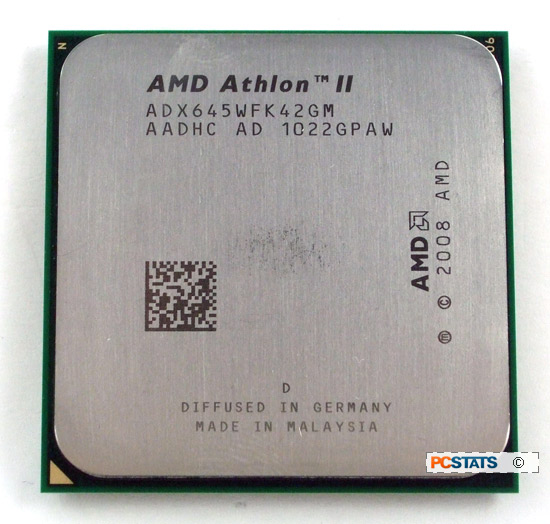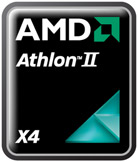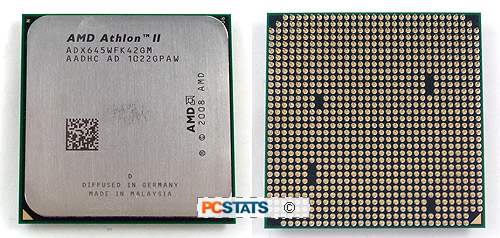In this review PCSTATS is testing AMD's latest
mainstream quad-core chip, the 3.1GHz Athlon II X4 645 processor.
Architecturally speaking the Athlon II X4 645 is identical to the preceding
Athlon II X4 635 model, except for a modest clock speed
increase. If you're familiar with the preceding few Athlon II X4 6-series
CPUs you'll know what to expect so jump ahead to the overclocking results and
benchmark tables.
Bringing the AII X4's
four cores past the 3GHz threshold affords incremental gains of course,
and the Athlon II X4 continues to be an ideal CPU for media PCs,
particularly when paired an AMD 890GX motherboard. If faced off against an Intel Core i5 or AMD
Phenom II X4 chip the Athlon II X4
family will bring up the rear, but if you're in need of a good all-around home PC system and
don't have much cash to splash around the platform offers exceptional value.
AMD's Athlon II X4 645 is a native socket AM3 processor
and is backwards compatible with older socket AM2+ motherboards, an element that
is clearly missing from Intel's expanding
circus of sockets. Just like the flagship processors, the Athlon II X4 645 will support 32-bit
or 64-bit versions of Microsoft Windows 7/Vista/XP operating
system, but best of all it's priced at an economical $122USD.
On the spec front, AMD's 3.1GHz Athlon II X4 645 processor
features 512KB of L2 cache for each of its four cores, for a total of 2MB.
Unlike the Phenom II quad-core designs, the Athlon II X4 lacks any L3 cache.
Platform compatibility is broad thanks to both DDR2 and DDR3 onboard memory
controllers, making it possible to install this processor on motherboards that
support DDR2-1066 or DDR3-1333 memory. For this review PCSTATS has selected the
ASUS Crosshair IV Forumla (890FX) motherboard and 4GB of Corsair XMS3-1600C9
DDR3 RAM. If you're building a new PC it's wise to go the DDR3-route as DDR2 is
being phased out.
 |
|
|
AMD Athlon II X4 645 Processor |
|
|
 |
| Tech
Specs |
|
Athlon II X4
645
(4 core / 4
thread)
Clock: 3.11GHz
L1: (4x) 128KB
L2: (4x)
512KB
L3: none
Multiplier: 15.5x
Package:
938-pin
Socket: AM3 mPGA
Core: 45nm DSL
SOI
Transistor: ~300M
Die Size; 169mm2
Power: 95W
Codename:
'Propus'
Cost: $122 USD |

| |
Manufactured on a 45nm SOI process at the Global Foundries
Fab 1 module in Dresden Germany, the Athlon II X4 645 is built on AMDs "Propus"
core - essentially a slimmed-down version of "Deneb" that's been around since
first Phenom II processor. This core design consists of four individual
computational cores (4-core, 4-thread) with 512KB of L2 cache for each. The
monolithic silicon die measures 169mm2 and contains 300 million transistors. Thermal Design Power (TDP) sits at a moderate
95W.

As
you might expect, the 3.1GHz Athlon II X4 645 processor supports full hardware
virtualization, so individual cores can be assigned to virtual machines. Built in virtualization is one
of the big features of Microsoft Windows 7, and it is this that makes running
Windows XP Mode inside of the Windows 7 operating system possible.
Retailing at launch for$122 CDN ($122 USD, £75 GBP) , the Athlon
II X4 645 processor continues to be one of the most affordable quad-core
CPUs on the market. Its primary competition will be coming from AMD's own Phenom
II X3 processors and Intel's Core i5 processors.
Athlon II = No L3
Cache
Fast L3 cache is important for communication between processor cores and multi-threading efficiency.
When all four cores are busy processing threads the
L3 cache acts as sort of a pool that feeds the individual L2 caches. Ultimately the
absence of L3 cache in the Athlon II family of processors increases the
frequency that the chip has to fetch information from system memory or virtual
memory (hard drive), both of which are orders of magnitude slower than
accessing quick on-die L3 cache.
In applications
which rely on streaming a lot of data into all four cores of the
computer processor from memory, the lack of L3 cache will hamper the AMD Athlon II X4 645 processor's performance compared
to equivalently paced quad-core Phenom II chips.

Let's see
how this Athlon II compares in the very competitive mainstream processor field.
First up a quick look at power consumption then PCSTATS will head straight into overclocking and then
our extensive benchmark set.
Core-by-Core CPU Power
Draw
CPU power draw (expressed in Watts) can be easily
measured by way of total system power if you have a simple electrical power
meter. To determine how much juice the CPU is consuming, we only need to compare
power draw with the processor resting at idle, and with each core at 100% CPU
utilization. For an accurate measurement it's necessary to disable power saving
features and CPU clock speed throttling technologies like Cool 'n' Quiet, EIST
(speedstep) and C1E power states, etc. To stress each core in the processor
individually, PCSTATS uses a free program called Stress Prime SP2004).
The power
draw for the entire PC system is measured with an Extech Power Analyzer Datalogger (model 380803). Given that
motherboards vary across these test systems this is not a pure measure of CPU
power draw alone, but rather a measurement of the total computer system power
draw, which we can compare for each specific platforms between the CPU idle and
CPU stressed states
| Total System Idle Power
Draw |
| Processor |
Total System Power Draw |
| Intel Pentium 4 540 |
   150 Watts 150 Watts |
| Intel Pentium D 840 |
   165 Watts 165 Watts |
| Intel Pentium D 940 |
   168 Watts 168 Watts |
| Intel Core 2 Duo E6600 |
   117 Watts 117 Watts |
| Intel Core 2 Duo E6750 |
   123 Watts 123 Watts |
| Intel Core 2 Duo E8400 |
   131 Watts 131 Watts |
| Intel Core 2 Duo E8500 |
   114 Watts 114 Watts
|
| Intel Core i5 750 |
   124 Watts 124 Watts
|
| Intel Core i7 920 |
   144 Watts 144 Watts
|
| AMD Sempron 3600+ |
   120 Watts 120 Watts |
| AMD Athlon64 4000+ |
   163 Watts 163 Watts |
| AMD Athlon64 FX-60 |
   127 Watts 127 Watts |
| AMD Athlon64 X2 4800+ |
   143 Watts 143 Watts |
| AMD Athlon64 X2 5000+ |
   156 Watts 156 Watts |
| AMD Athlon64 FX-62 |
   168 Watts 168 Watts |
| AMD Athlon II X2 240e |
   122 Watts 122 Watts
|
| AMD Athlon II X2 250 |
   128 Watts 128 Watts
|
| AMD Athlon II X3 435 |
   128 Watts 128 Watts
|
| AMD Athlon II X4 620 |
   130 Watts 130 Watts
|
| AMD Athlon II X4 635 |
   127 Watts 127 Watts
|
 AMD Athlon II X4 645 AMD Athlon II X4 645 |
   120 Watts 120 Watts |
| AMD Phenom II X2 550 BE |
   145 Watts 145 Watts
|
| AMD Phenom II X2 555 BE |
  143 Watts 143 Watts
|
| AMD Phenom II X3 720 BE |
   155 Watts 155 Watts |
| AMD Phenom II X4 910e |
   131 Watts 131 Watts |
| AMD Phenom II X4 955 BE (125W) |
  148 Watts 148 Watts |
| AMD Phenom II X4 965 BE (125W) |
   150 Watts 150 Watts
|
| AMD Phenom II X4 965 BE (140W) |
   150 Watts 150 Watts
|
| AMD Phenom II X4 BE 970BE |
   134
Watts 134
Watts |
| AMD Phenom II X6 BE 1075T |
   129
Watts 129
Watts |
| AMD Phenom II X6 BE 1090T |
   130
Watts 130
Watts |
Even with a couple
hundred extra MHz under the hood, the Athlon II X4 645 PC system idles at 120 Watts, a
hair lower than the AII X4 635 and 620 models. We'll see where the power draw figures stand once the system is under
stress, for each of the Athlon II X4 645's four processing cores...
| Total System Stressed
Power Draw - All Cores/Threads |
| Processor |
Total System Power Draw (All Cores) |
| Intel Pentium 4
540 |
   223 Watts 223 Watts |
| Intel Pentium D
840 (2 Core ) |
   240 Watts 240 Watts |
| Intel Pentium D
940 (2 Core Load) |
   253 Watts 253 Watts |
| Intel Core 2
Duo E6600 (2 Core Load) |
   156 Watts 156 Watts |
| Intel Core 2
Duo E6750 (2 Core Load) |
   163 Watts 163 Watts |
| Intel Core 2
Duo E8400 (2 Core Load) |
   158 Watts 158 Watts |
| Intel Core 2 Duo E8500 (2 Core) |
   149W 149W |
| Intel Core i5
750 (4 Core Load) |
   169 Watts 169 Watts |
| Intel Core i7
920 (8 Thread Load) |
   213 Watts 213 Watts |
| AMD Sempron
3600+ |
   148 Watts 148 Watts |
| AMD Athlon64
4000+ |
   172 Watts 172 Watts |
| AMD Athlon64
FX-60 (2 Core Load) |
   196 Watts 196 Watts |
| AMD Athlon64 X2
4800+ (2 Core Load) |
   173 Watts 173 Watts |
| AMD Athlon64 X2
5000+ (2 Core Load) |
   207 Watts 207 Watts |
| AMD Athlon64
FX-62 (2 Core Load) |
   235 Watts 235 Watts |
| AMD Athlon II
X2 240e (2 Core Load) |
   153 Watts 153 Watts |
| AMD Athlon II
X2 250 (2 Core Load) |
   163 Watts 163 Watts |
| AMD Athlon II
X3 435 (3 Core Load) |
   183 Watts 183 Watts |
| AMD Athlon II
X4 620 (4 Core Load) |
   195 Watts 195 Watts |
| AMD Athlon II X4 635 (4 Core Load) |
   211 Watts 211 Watts |
 AMD Athlon II X4 645 (1 Core
Load) AMD Athlon II X4 645 (1 Core
Load) |
   139 Watts 139 Watts |
 AMD Athlon II X4 645 (2 Core
Load) AMD Athlon II X4 645 (2 Core
Load) |
   158 Watts 158 Watts |
 AMD Athlon II X4 645 (3 Core
Load) AMD Athlon II X4 645 (3 Core
Load) |
   177 Watts 177 Watts |
 AMD Athlon II X4 645 (4 Core
Load) AMD Athlon II X4 645 (4 Core
Load) |
   193 Watts 193 Watts |
| AMD Phenom II X2 550 Black Edition (2 Core
Load) |
   181 Watts 181 Watts |
| AMD Phenom II X2 555 Black Edition (2 Core
Load) |
   187 Watts 187 Watts |
| AMD Phenom II X3 720 (3 Core Load) |
   213 Watts 213 Watts |
| AMD Phenom II X4 910e (4 Core Load) |
   176 Watts 176 Watts |
| AMD Phenom II
X4 955 (4 Core Load) |
  236 Watts 236 Watts |
AMD Phenom II X4 965 - 125W TDP
(4 Core Load) |
   243 Watts 243 Watts |
AMD Phenom II
X4 965 - 140W TDP
(4
Core Load) |
   264 Watts 264 Watts |
| AMD Phenom II X4 970 BE ( 4 Core Load) |
   214 Watts 214 Watts |
| AMD Phenom II X6 1075T (6 Core) |
   228 Watts 228 Watts |
| AMD Phenom II X6 1090T (6 Core) |
   263W 263W |
The power draw for the Athlon II X4
645 PC increases to 193 Watts with all four cores 100% stressed. Compared
to the considerably faster Core i5 750 system (169W), the Athlon II X4 645
system demands a lot. AMD really needs to move its Athlon II processors to 32nm.
Next up, PCSTATS overclocks the Athlon II X4 645 chip towards 4GHz, then
it's onto the processor benchmarks!

